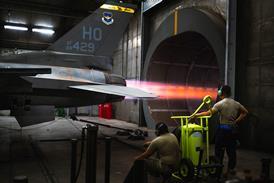Ultra Electronics has launched what it hopes will be a revolution in military airframe maintenance with a system that monitors - in real time, during flight - the development and propagation of cracks in aluminium structures.
While crack control traditionally depends on costly, time-consuming on-the-ground inspections at intervals determined by flight hours, Ultra's Asis system can identify cracks as they appear by listening for their tell-tale sound.
Building on Ultra's expertise in acoustic technology in sonar and noise cancellation applications, the Asis system consists of an array of piezoelectric sensors bonded to the airframe, which feed data to a pre-amplifier and then, depending on the size of the aircraft, to one or two remote data concentrators and then to a data storage unit. By analysing the difference in time that an acoustic event arrives at each sensor, Asis determines the location of the crack.
On the ground, a technician using a tablet computer and hand-held sensor can locate to the rivet where a crack has occurred, allowing, for example, a problem to be resolved quickly and cheaply by removing a single rivet, cold-working the hole, and re-riveting.
Marketing director Rob McDonald calls the creation of Asis an "iPad moment" for Ultra, as it developed the system for a niche it has identified - militaries that are having to maintain ageing fleets - rather than in response to a specific request for proposals.
He says sales are being targeted at the USA, where large numbers of aircraft many decades old are expected to continue in service for decades to come.
No other non-destructive testing system can be fitted to an aircraft and measure its structural integrity during flight, says McDonald. Also attractive, he says are the minimal size and weight of the system - much of the mass is in the wiring harness, but the remote data concentrators are smaller than a cigarette pack and the data storage unit about the size of a Dan Brown paperback - and the fact that the sensors can be fitted without drilling any holes in an ageing aircraft.
The cost of an installation is about $65,000 for a helicopter, and maybe as much as three times that for a P-3. Some systems are scheduled for delivery later this year, as part of US military trials.
Developments in the pipeline include integration with a unit that measures the aircraft's roll, pitch and yaw acceleration to provide a visual depiction of crack events as they occurred during flight. Then, with better understanding of the manoeuvres that cause airframe damage on each individual aircraft in a fleet, Asis could help a fleet manager decide which aircraft to use, or not use, on particularly stressful missions.
An earlier system that McDonald describes as more like laboratory equipment than a saleable product was tested on P-3s in use as firefighters. Firefighting aircraft are particularly good applications for Asis, he says, because they are typically aged airframes being used under violent loading conditions.
- All the latest news, video and images from the 2010 Farnborough air show - New this year, live streaming video of each day's flying display
Source: Flight Daily News























